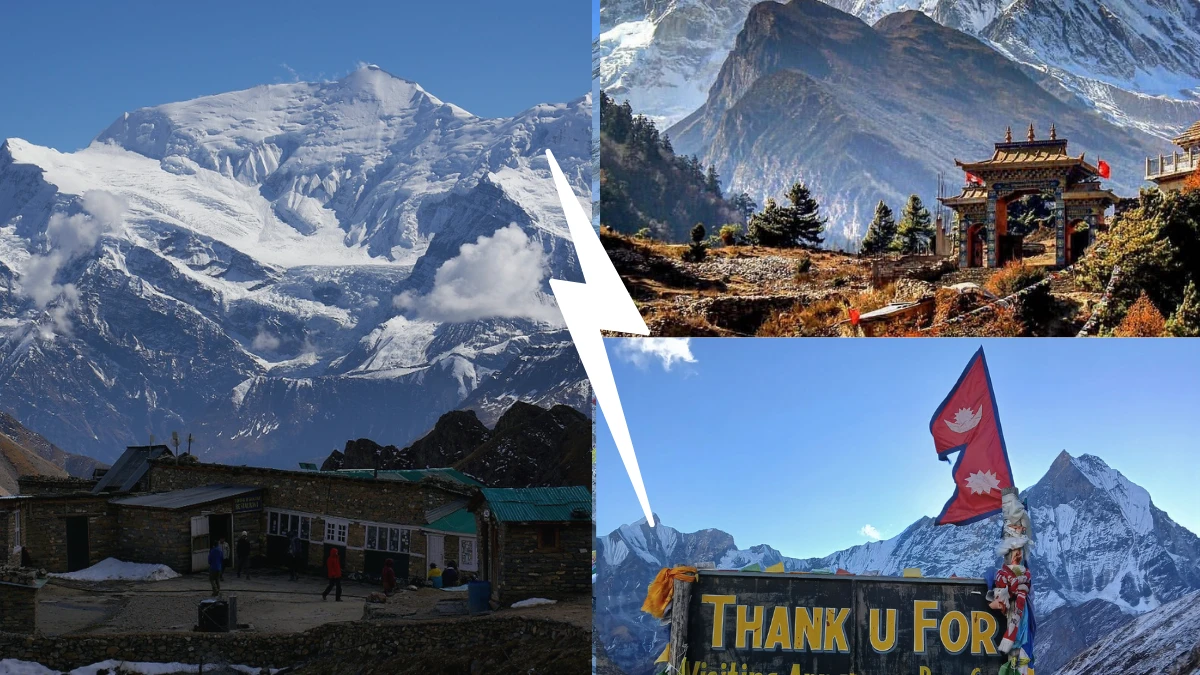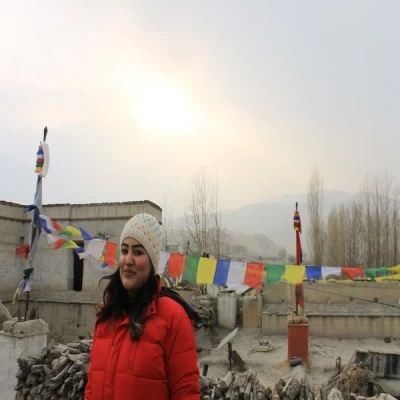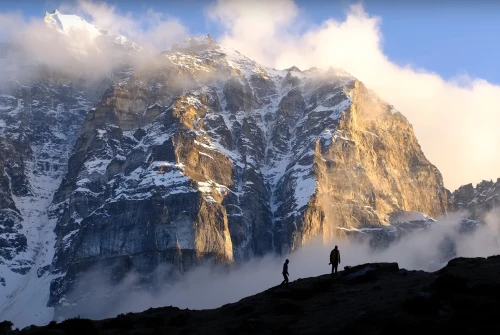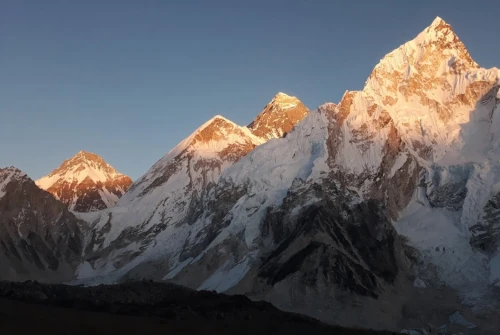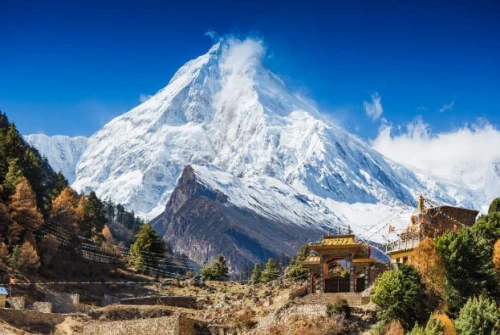Overview: Exploring Nepal's Three Most Iconic Treks
Nepal, nestled in the heart of the Himalayas, offers a wide array of trekking experiences, each with its distinct charm. Among the most prominent treks are the Manaslu Circuit Trek (MCT), the Annapurna Base Camp (ABC) Trek, and the legendary Everest Base Camp (EBC)Trek. While they all promise awe-inspiring mountain views and immersive cultural experiences, they differ vastly in terms of remoteness, physical demands, altitude, costs, logistics, and overall experience. Choosing the right trek depends on what kind of adventure you’re after, whether it's raw wilderness, scenic variety, or the prestige of standing at the foot of the world’s highest peak.
The Manaslu Circuit Trek is gaining popularity among trekkers seeking off-the-beaten-path experiences, far from the more commercial routes. It circles the 8th highest mountain in the world, Mt. Manaslu (8,163m), passing through remote Tibetan-influenced villages, deep river gorges, and eventually crossing the dramatic Larkya La Pass. It’s ideal for trekkers craving solitude, raw landscapes, and cultural depth. However, it’s also physically demanding and less developed in terms of infrastructure, requiring more logistical preparation and a licensed guide.
On the other end, the Annapurna Base Camp Trek is a relatively moderate trek that offers an incredible diversity of landscapes, from lush terraced farmland and rhododendron forests to the high alpine sanctuary of the Annapurna Massif. It is more accessible, suitable for beginners and those short on time, and offers good facilities throughout the trail. Everest Base Camp, meanwhile, remains the bucket-list trek for thousands of trekkers annually. It's more commercial, with well-established infrastructure, yet its high elevation, harsh climate, and tough acclimatization schedule make it challenging. You get up close with Everest and walk among legendary peaks, but you’ll also share the trail with many others.
Location and Accessibility
Each trek starts in a distinctly different region of Nepal, affecting both the travel logistics and the experience.
Manaslu Circuit Trek begins with a long road journey, approximately 8 to 10 hours of rugged driving from Kathmandu to Soti Khola or Machha Khola. The region lies in the Gorkha District, bordering Tibet. There’s no airport access, so trekkers must brace for bumpy jeep rides. This limited accessibility is one reason the trail remains quiet and uncrowded.
Annapurna Base Camp is arguably the easiest to access. Most treks start from Pokhara, which is either a 25-minute flight or a 6–8 hour drive from Kathmandu. From Pokhara, a short drive takes you to trailheads like Nayapul or Ghandruk. Accessibility to this trek is one of its greatest advantages, especially for those looking for shorter holidays.
Everest Base Camp, in contrast, starts with one of the most exhilarating flights in the world to Lukla Airport. The flight is just 30 minutes from Kathmandu but is notoriously weather-dependent and often delayed or canceled. For those seeking prestige and thrill, this route kicks off with a punch, but it also means you’re immediately immersed in high altitude and among crowds of international trekkers.
Scenery and Landscapes
The landscapes differ dramatically, offering contrasting Himalayan environments.
Manaslu Circuit offers some of the most diverse and wild landscapes in Nepal. The trail starts in lowland jungles and rice paddies, transitions into cliffs and gorges carved by the Budi Gandaki River, and ascends into high alpine meadows and glaciers. The highlight, the Larkya La Pass at 5,160m, gives panoramic views of Himlung Himal, Cheo Himal, Kang Guru, and Annapurna II. Few treks offer such variety, with villages like Sama Gaun appearing like time capsules of Himalayan heritage.
Annapurna Base Camp, though lower in elevation, is no less stunning. It takes trekkers through dense rhododendron and bamboo forests, past terraced villages, and into the heart of the Annapurna Sanctuary, a natural amphitheater ringed by giants like Annapurna I, Machapuchare (Fishtail), and Hiunchuli. You’ll constantly feel embraced by mountains, especially at sunrise and sunset. The lushness and floral beauty contrast strongly with Manaslu's rawness.
Everest Base Camp is dominated by rugged, high-altitude alpine terrain. It’s a drier, harsher environment, especially after Namche Bazaar. You’ll walk through sherpa villages, glacial moraines, and yak pastures, all under the shadow of towering peaks like Ama Dablam, Lhotse, Nuptse, and Everest itself. A side trip to Kala Patthar provides the best views of Everest, often missed from the actual base camp. The high-altitude desert feel and sheer scale of the peaks create an otherworldly atmosphere.
Best Viewpoint, Attractions & Sunrise/Sunset Highlights in Each Trek
When trekking through the Himalayas, the right viewpoint or moment of sunrise can turn an already epic journey into something truly spiritual. Each of these three iconic treks — Manaslu Circuit, Annapurna Base Camp, and Everest Base Camp — has distinct highlights when it comes to breathtaking vistas, unique places, and those magical golden hours.
Manaslu Circuit Trek Highlights
Best Viewpoint: Larkya La Pass (5,160m)
Larkya La Pass is not only the highest point of the Manaslu Circuit but also the most dramatic viewpoint on the entire route. As you reach the saddle after a long uphill climb, you’re greeted with sweeping, panoramic views of the Himlung Himal (7,126m), Cheo Himal (6,820m), Kangguru (6,981m), and even parts of the Annapurna Range in the distance. The sunrise colors reflecting on glaciers and peaks from this viewpoint are beyond words.
Best Attraction Place: Sama Gaun Village
Sama Gaun (3,520m) is the cultural and scenic gem of the Manaslu region. It’s a traditional Nubri village surrounded by high mountains, with Mt. Manaslu towering directly overhead. The side hike to Manaslu Base Camp or Pungyen Gompa, a hidden monastery perched on a hill, makes it an unforgettable base for exploration.
Best Sunrise/Sunset Place: Sho or Lho Village
From Sho (2,880m) and Lho (3,180m), the sunrise over Mt. Manaslu and adjacent peaks is simply stunning. In Lho, you can climb up to Ribung Monastery early in the morning for a peaceful, golden-lit panorama of the Manaslu massif, often with clear skies and a spiritual ambiance.
Annapurna Base Camp Trek Highlights
Best Viewpoint: Annapurna Base Camp (4,130m)
The Annapurna Sanctuary itself is a natural viewpoint — a 360-degree bowl of icy peaks. Standing at ABC, you're surrounded by Annapurna I, Fishtail, Hiunchuli, Annapurna South, and Tent Peak. It’s one of the few places where you feel completely enclosed by giants.
Best Attraction Place: Jhinu Danda Hot Springs
After descending from ABC, trekkers love relaxing at the Jhinu Danda hot springs, situated next to the Modi River. The warm, natural pools offer a healing experience for sore muscles with a jungle setting and the sound of rushing water all around.
Best Sunrise/Sunset Place: Poon Hill (3,210m)
Although slightly off the direct ABC route, Poon Hill is often added as a side trip, and for good reason. It offers arguably the best sunrise view in the Annapurna region, with golden light painting Dhaulagiri, Annapurna South, Nilgiri, and Machapuchare. It’s a favorite among photographers and nature lovers.
Everest Base Camp Trek Highlights
Best Viewpoint: Kala Patthar (5,545m)
Kala Patthar is without a doubt the ultimate viewpoint in the Everest region. From here, you get a head-on, unobstructed view of Mt. Everest (8,848.86m) — something you don’t actually see well from Base Camp itself. Alongside Everest, you’ll see Lhotse, Nuptse, Pumori, Ama Dablam, and more. Early morning climbs are cold, but reward you with a surreal Himalayan sunrise above the world.
Best Attraction Place: Tengboche Monastery
At 3,867m, Tengboche Monastery is a spiritual and cultural highlight. It’s the largest monastery in the Khumbu region and offers mesmerizing views of Ama Dablam, especially at sunrise. Participating in a morning or evening Buddhist prayer session here adds a peaceful and meaningful touch to your trek.
Best Sunrise/Sunset Place: Everest View Hotel & Dingboche Ridge
From Everest View Hotel (3,880m) near Namche, you can enjoy a luxury sunrise coffee with a view of Everest, Lhotse, and Ama Dablam.
- In Dingboche, climbing the ridge above the village during sunset gives fiery colors on Island Peak, Lhotse, and Thamserku, offering solitude and surreal silence.
Final Highlight Table: Scenic Treasures at a Glance
Category | Manaslu Circuit | Annapurna Base Camp | Everest Base Camp |
Best Viewpoint | Larkya La Pass | Annapurna Base Camp | Kala Patthar |
Best Attraction | Sama Gaun Village & Pungyen Gompa | Jhinu Hot Springs | Tengboche Monastery |
Best Sunrise/Sunset Spot | Lho Monastery (Manaslu sunrise) | Poon Hill (sunrise over Dhaulagiri & Annapurna) | Kala Patthar (sunrise over Everest), Dingboche Ridge (sunset) |
Duration and Itinerary
All three treks differ in duration, affecting planning and acclimatization.
- Manaslu Circuit typically takes 14–17 days, due to its circuit nature and the necessity to acclimatize gradually. Side trips to Manaslu Base Camp or Pungen Gompa can add extra days.
- Annapurna Base Camp is more flexible. The shortest itinerary is 7 days, but adding side trails like Ghorepani-Poon Hill or Jhinu Danda hot springs can extend it to 10–12 days.
- Everest Base Camp requires around 12–14 days, with mandatory acclimatization stops in Namche and Dingboche. Skipping these increases the risk of altitude sickness.
So, if you have limited time, ABC is ideal. If you're after a full-circle immersive journey, Manaslu offers more depth. And if you're chasing an iconic goal, EBC is the one, but you’ll need the stamina and flexibility.
Difficulty and Altitude Challenges
The treks are not equal in difficulty, and altitude plays a central role.
Manaslu Circuit reaches a max altitude of 5,160m, which is higher than both ABC and EBC. The Larkya La Pass crossing is a long and demanding day. The trail has more elevation gain and descent than most, making it physically challenging. Additionally, the isolation means limited medical facilities or evacuation options. Prior trekking experience is recommended.
Annapurna Base Camp tops out at just 4,130m, making it the least risky in terms of altitude sickness. The trail, though steep in parts, is well-marked and supported. It’s ideal for first-time trekkers or families. However, don't mistake it for “easy” the steep stone staircases around Chhomrong and Deurali can still test your knees and lungs.
Everest Base Camp, although lower in max elevation than Larkya La, is more strenuous due to the prolonged exposure to high altitude. Most of the trail is above 3,500m. The cold, dry air and thin oxygen levels can wear down even fit trekkers. Acclimatization and hydration are critical.
Accommodation and Infrastructure
This is where the contrast between these three treks becomes most apparent.
Manaslu Circuit has basic teahouses, with shared toilets, limited food menus, and no heating. Many villages have solar or firewood-based hot showers, but services drop off the higher you go. Despite being raw, the authenticity of these tea houses adds charm to the experience.
ABC Trek has excellent infrastructure. The teahouses are well-managed, rooms are clean, food is hygienic, and hot water is available at most stops. Some lodges in Ghandruk, Chhomrong, and Bamboo even offer attached bathrooms. It strikes a perfect balance between wilderness and comfort.
EBC Trek has the most advanced amenities, especially in Namche Bazaar, Lukla, and Dingboche. You’ll find Wi-Fi, bakeries, gear shops, and even cinemas. However, prices rise with altitude — a bottle of water at Gorakshep can cost $4–$5. Comfort comes with crowds, and booking lodges in peak season can be tough.
Cultural Immersion
Each trek provides a unique cultural backdrop, shaped by the local ethnic communities.
Manaslu is culturally tied to Tibetan Buddhism. Villages like Lho, Sho, and Sama Gaun reflect this heritage, with mani walls, chortens, and centuries-old monasteries. The Nubri people, a Tibetan ethnic group, maintain a semi-nomadic, spiritually rich lifestyle. You'll experience a more authentic culture due to the low tourist traffic.
ABC Trek goes through Gurung and Magar villages, known for their warm hospitality. You’ll hear folk songs, taste homemade raksi (local alcohol), and see traditional dress. Villages like Ghandruk and Landruk have cultural museums, offering richer community interaction.
EBC Trek, while more commercial, still offers Sherpa culture, steeped in Buddhist values and mountaineering history. Tengboche Monastery is a spiritual highlight, where you can attend daily pujas. However, commercialization along the route somewhat dilutes the cultural experience compared to Manaslu.
Permits and Costs
Trek | Permits Required | Estimated Total Permit Fees | Notes |
Manaslu | RAP, ACAP, MCAP | $100–$150+ (based on days) | Licensed guide mandatory |
ABC | ACAP, TIMS | $30–$40 | No guide required, but optional |
EBC | Sagarmatha Permit, Khumbu Municipality | $50–$60 | No TIMS required for EBC |
Manaslu is the most regulated and requires a minimum of two trekkers and a guide. EBC is the most expensive overall, considering the permit and daily cost. ABC is the most budget-friendly, perfect for solo trekkers or students.
Views from Each Trek: What Will You Witness Along the Trail?
Manaslu Circuit Trek Views
The Manaslu Circuit presents some of the most raw and untouched Himalayan landscapes in Nepal. You'll walk beside the wild Budi Gandaki River, pass through dense subtropical forests, and gradually ascend into barren alpine zones. The star attraction is, of course, Mt. Manaslu (8,163m), which reveals itself as you reach Lho and Sama Gaun, with a stunning pyramid-shaped peak that dominates the horizon. Other major views include Himalchuli, Ngadi Chuli, and Cheo Himal, especially visible during the Larkya La Pass crossing, where you’ll witness an expansive glacial plateau, dramatic ridgelines, and the longest Himalayan pass walk that feels endless in the best way. The entire trail gives off a true sense of isolation and grandeur, ideal for photography lovers and trekkers seeking visual drama.
Annapurna Base Camp Trek Views
ABC offers more green and lush mountain scenery, with sharp contrasts between dense forest zones and towering icy peaks. You’ll trek through rhododendron groves and cross suspension bridges with Machapuchare (Fishtail Peak) teasing you in the distance. Once you reach the Annapurna Sanctuary, the views open up into a 360-degree amphitheater of mountains, including Annapurna I (8,091m), Annapurna South, Hiunchuli, and Fishtail. The sunrise over this enclosed bowl is absolutely magical, making it one of the best morning views in Nepal. Unlike Manaslu or Everest, the peaks feel closer and more intimate in ABC.
Everest Base Camp Trek Views
EBC delivers the most iconic mountain vistas in the world. From your first day in Lukla, you begin walking beneath towering giants. The highlight is the approach to Kala Patthar (5,545m), from where you'll have the best panoramic view of Mt. Everest, along with Lhotse, Nuptse, Ama Dablam, Pumori, and Thamserku. The Khumbu Icefall, glaciers, and even the Everest summit plume can be seen if the skies are clear. The landscape is stark and dramatic, especially above Dingboche, where you leave the treeline and enter a world of rock, snow, and silence.
Who Is Each Trek For?
Each of these treks attracts a different kind of traveler based on difficulty, scenery, cultural richness, and time availability.
Manaslu Circuit is for...
- Adventurous trekkers looking for a remote and less crowded trail.
- Those who want a blend of cultural immersion and rugged landscapes.
- Trekkers with prior experience, good physical fitness, and a taste for off-the-beaten-path destinations.
- People who enjoy longer treks with diverse environments, from jungles to glaciers.
Annapurna Base Camp is for...
- First-time trekkers or those seeking a shorter yet rewarding Himalayan experience.
- Families and groups looking for comfort, accessibility, and beautiful scenery without extreme altitude.
- Travelers with limited time or budget who still want to witness major peaks up close.
- Nature lovers interested in lush greenery, wildlife, and traditional Gurung/Magar villages.
Everest Base Camp is for...
- Trekkers with moderate to high fitness levels are aiming to experience the prestige of Everest.
- Those who have a dream to see Everest up close and want to tick it off their bucket list.
- People who are okay with crowds, high prices, and tough acclimatization schedules.
- Cultural enthusiasts who wish to learn about the Sherpa community and high-altitude lifestyle.
Which Trek is Family-Friendly and Why?
Among the three, the Annapurna Base Camp Trek is the most family-friendly for several reasons:
- Lower maximum altitude (4,130m) significantly reduces the risk of acute mountain sickness (AMS), making it safer for children and older trekkers.
- The trail is well-developed, offering better accommodations, food options, and easier access to emergency evacuation if needed.
- Shorter versions of the trek (e.g., starting from Ghandruk) can be completed in 7–8 days, allowing flexibility for families with school holidays or limited time.
- The trail has lots of villages along the way where rest days or cultural interaction can be integrated — perfect for kids or non-avid hikers.
- Hot springs at Jhinu Danda make for a fun and relaxing stop for all ages.
Everest Base Camp, while iconic, is less suitable for families unless everyone is fit and well-acclimatized. The altitude is higher, and facilities in upper villages are limited or expensive. Manaslu Circuit is the least family-friendly, given the remoteness, rough terrain, longer days, and required permits that demand group and guide participation.
Comparison Table
Feature | Manaslu Circuit | Annapurna Base Camp | Everest Base Camp |
Region | Gorkha | Annapurna | Khumbu (Everest) |
Access | Long drive from Kathmandu | Drive/flight to Pokhara | Flight to Lukla |
Duration | 14–17 days | 7–12 days | 12–14 days |
Max Altitude | 5,160m (Larkya La) | 4,130m (ABC) | 5,545m (Kala Patthar) |
Difficulty | Hard | Moderate | Moderate to Hard |
Permit Requirements | RAP, ACAP, MCAP | ACAP, TIMS | Sagarmatha, Khumbu Permit |
Accommodation | Basic teahouses | Well-developed lodges | Advanced facilities |
Cultural Exposure | Tibetan Buddhist, Nubri | Gurung, Magar | Sherpa Buddhist |
Crowds | Low | Moderate | High |
Scenery | Remote, wild, diverse | Lush, forested, close-up peaks | Harsh alpine, glacier, iconic mountains |
Cost | Medium to High | Budget | High |
